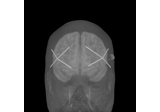mne.io.read_raw_hitachi#
- mne.io.read_raw_hitachi(fname, preload=False, verbose=None)[source]#
Reader for a Hitachi fNIRS recording.
- Parameters:
- fname
str Path to the Hitachi CSV file.
- preloadbool or
str(defaultFalse) Preload data into memory for data manipulation and faster indexing. If True, the data will be preloaded into memory (fast, requires large amount of memory). If preload is a string, preload is the file name of a memory-mapped file which is used to store the data on the hard drive (slower, requires less memory).
- verbosebool |
str|int|None Control verbosity of the logging output. If
None, use the default verbosity level. See the logging documentation andmne.verbose()for details. Should only be passed as a keyword argument.
- fname
- Returns:
- rawinstance of RawHitachi
A Raw object containing Hitachi data.
See also
mne.io.RawDocumentation of attribute and methods.
Notes
Hitachi does not encode their channel positions, so you will need to create a suitable mapping using
mne.channels.make_standard_montage()ormne.channels.make_dig_montage()like (for a 3x5/ETG-7000 example):>>> mon = mne.channels.make_standard_montage('standard_1020') >>> need = 'S1 D1 S2 D2 S3 D3 S4 D4 S5 D5 S6 D6 S7 D7 S8'.split() >>> have = 'F3 FC3 C3 CP3 P3 F5 FC5 C5 CP5 P5 F7 FT7 T7 TP7 P7'.split() >>> mon.rename_channels(dict(zip(have, need))) >>> raw.set_montage(mon)
The 3x3 (ETG-100) is laid out as two separate layouts:
S1--D1--S2 S6--D6--S7 | | | | | | D2--S3--D3 D7--S8--D8 | | | | | | S4--D4--S5 S9--D9--S10
The 3x5 (ETG-7000) is laid out as:
S1--D1--S2--D2--S3 | | | | | D3--S4--D4--S5--D5 | | | | | S6--D6--S7--D7--S8
The 4x4 (ETG-7000) is laid out as:
S1--D1--S2--D2 | | | | D3--S3--D4--S4 | | | | S5--D5--S6--D6 | | | | D7--S7--D8--S8
The 3x11 (ETG-4000) is laid out as:
S1--D1--S2--D2--S3--D3--S4--D4--S5--D5--S6 | | | | | | | | | | | D6--S7--D7--S8--D8--S9--D9--S10-D10-S11-D11 | | | | | | | | | | | S12-D12-S13-D13-S14-D14-S16-D16-S17-D17-S18
For each layout, the channels come from the (left-to-right) neighboring source-detector pairs in the first row, then between the first and second row, then the second row, etc.
New in version 0.24.
